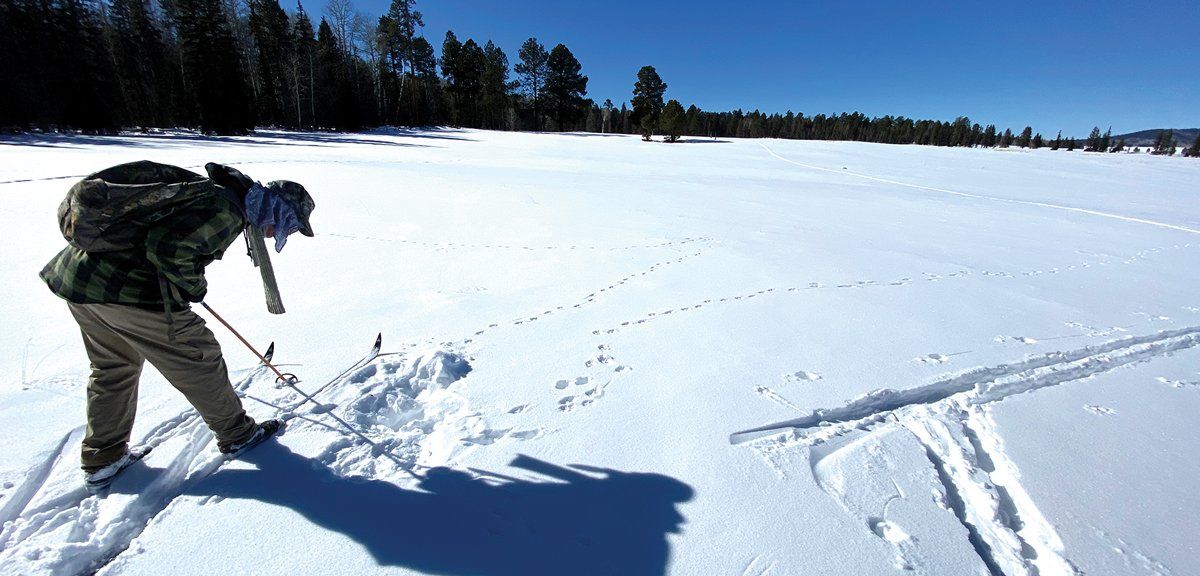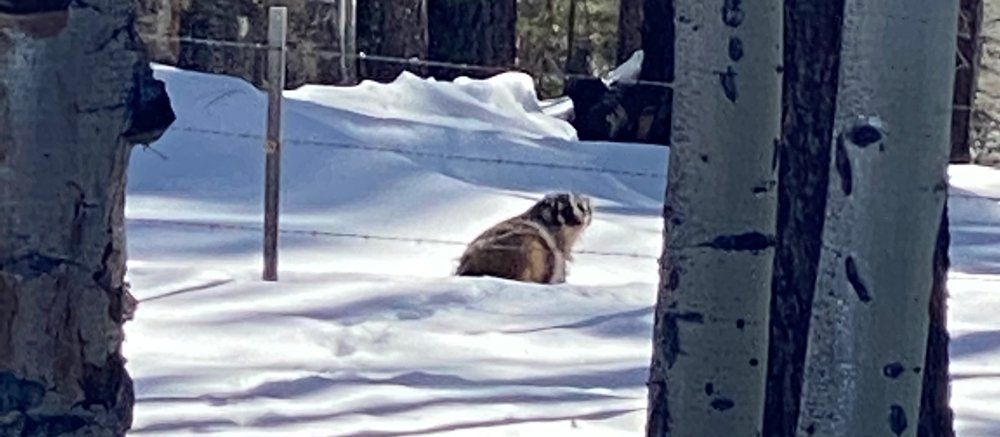Cross-Country Skiing the White Mountains

“One should not dread the winter, it too has its bounties, the snow gives warmth and deadens the tumult and its pale days are soon over.” -- Samuel Beckett
You know the old expression: “Don’t like mountain weather; wait an hour and it’ll change.” Missing from that adage is the fact that our weather varies not only temporally, but spatially as well. In other words, simply by going up or down in elevation a thousand feet, one can vary their environment significantly.
As a recent example of altering my “climate zone” let me evoke a pattern from this past January. On New Year’s Day, we finally got enough snow for some decent cross-country skiing. My standard practice when we get half a foot or more of snow is to ski first in the neighborhood; before the plows scrape our unpaved roads down to the dirt. Once conditions become marginal in the hood, I then move up to a local park, where I can ski on the soccer fields or the disc golf course. Later still, I have to move up in elevation about 500 feet and then ski on a closed Forest Service road that is well used by local skiers.
But a few days after our January 1st snowfall, we had a warming trend and it didn’t take long for in-town skiing to become sloppy and unenjoyable. Fortunately, my friend Anne (yes, the founder, publisher, and life-force behind OUTDOORS SOUTHWEST) suggested we seek out better skiing “up the mountain” a thousand or so feet in elevation. Despite a few trips I’ve made over the years to ski at Pole Knoll, I don’t typically opt to drive the 30-40 minutes that it takes to get there. And as far as other skiable spots either at Sunrise Resort (which has both downhill and cross-country) or on the Apache-Sitgreaves National Forest lands (the A/S) I have only made a very few trips to those sites in the 16+ years that I’ve lived near Lakeside.
Nonetheless, Anne had heard that the higher elevations (~8500’ and above) still had good snow so, during the second half of January, we made three ski trips up to the A/S and enjoyed two days when the conditions were ideal and one day where the snow clumped up on our skis and made progress difficult. On the better days, when we hit things just right, the days were calm and the air temperatures ideal (30-40F). Likewise, on the good days, the snow temperatures were in their sweet spot for our skis, and even when we had to break trail, the snow didn’t cake up on our ski bottoms. The few people we saw in the area where we skied were all just out to play with their dogs in the snow and we soon left them behind in the parking area. As such, we had our improvised trails (ungroomed and mostly unvisited by previous skiers) all to ourselves, which in my case, since I managed to spill on several occasions, was a blessing.
Among the more memorable images from those outings were such basic features as the snow and the sky. Let’s start at the top, with the sky. Most of us have probably noticed how intensely blue the sky can be at higher elevations, especially in winter, when it looms in such stark contrast to the blinding white snow. I’ve been told that mountain skies appear so blue because there is less moisture in the air and I would imagine that it might also be due to less particulate matter, as well.
In parts of the A/S where we skied, we traversed open grasslands where only the tippy-tops of the foot-high, dried grasses poked through the snow. In such areas, the forests and mountains were far enough away that it felt like we were skiing in open tundra. In this type of terrain, the sky really captured my attention, like a piercingly blue dome, 360 degrees around and above us. As I skied I pondered the different words the English language can employ to describe the many shades of blue, and they all seemed inadequate in describing the sky above me. I finally decided I needed to coin a new word for the heavens and decided upon: bivure. I will leave it to readers to puzzle out how my mind was working at the time, and by what logic I hit upon the creation of this silly new word.
And speaking of words, be they nouns or adjectives, many of us have heard that the Inuit’s supposedly have over 20 different words that they can use for “snow.” When I heard this as a kid, I remember thinking it was amazing to have so many words to describe something as common as snow (I grew up in Michigan, so we often had long winters where snow was a regular feature of the landscape). But 10 or so years later, I took up cross-country skiing and it quickly became apparent that yes, the Inuit’s had it right: there are many different kinds of snow.
Just in the three days that Anne and I went skiing on the A/S lands, we encountered snow that could variously be described as powdery, packed, crusty, fluffy, sugary, icy, slushy, patchy, drifty, and, well, you get the point. All of that in just a couple of square miles of terrain over just three days of late January weather. So, I guess it’s not at all hard to see how a people who live and endure in an essentially frozen world would not only want to come up with 20 words for snow, but in fact, might have found that their very survival depends on such precision and specificity of language.
When the snow’s texture was ideal and one’s mind stopped thinking in terms of how the unique snow conditions did, or did not, suit one’s skis, our progress across the land became a truly blissful form of locomotion. There was no slipping, no clumping, just perfect “kick and glide.” Our pace was faster than walking, maybe about the speed of jogging, but took so little effort that it allowed one to turn off the mind, and just enjoy fluid motion and stunning scenery.
Despite these periods when we experienced the Zen of perfect, skiable snow, there was frequently something so intriguing to the eye that the brain was pulled back into linear thinking, as it tried to make sense of some particular aspect of the environment. Animal tracks were one such intrusion, welcome though they were, as a riddle for the mind to solve. During my years at the University of Montana, while pursuing a degree in Wildlife Biology, I had the pleasure of taking Mammology and I especially enjoyed the one day’s lecture when the professor gave us a crash course in identifying mammals by their tracks.
Unfortunately, over the 40+ years that it’s been since I took that class, I haven’t really kept fluent in the silent language of tracks. Like many people, if conditions are right, I can differentiate some of the unguligrade tracks (deer from elk from javelina, for example). I can also usually distinguish a few of the digitigrade tracks (well, at least the canid or dog family from the felid or cat family). I can also tell if a set of tracks belongs to a mouse, a squirrel, or a rabbit. Lastly, most of the plantigrade tracks are distinctive (including raccoons, bears, and humans) and are easy to identify. But telling a coyote from a dog from a fox from a wolf, well, I would have to have a field guide to jog my memory and the tracks would have to be fresh and clear, as they might be in soft loamy soil. Snow tracks can be a challenge, in that they can change fairly quickly depending on the intensity of the sun, the temperature of the air, and by how much the wind is blowing.
Nonetheless, at one point we came to a fairly fresh line of canid tracks, wild canid, as there were no human tracks around and it seemed unlikely a dog would be off on its own so far from the parking area. Anne and I stopped to study the tracks and followed them to a point where we deduced that a large fox or a small coyote had detected the scent and/or sound of a small rodent, and leapt up high enough to pounce at its prey under about a foot of snow. There was no blood but the predator had dug down into the snow deep enough to hit earth and had pawed up a bit of soil. This particular style of hunting by wild canids is known as “mousing” and if you spend enough time out in snow country, you stand a good chance of seeing such a sign, or perhaps, even witnessing the behavior directly.
On our last day of skiing and on our way back to Pinetop, Anne noticed a medium-sized animal crossing the road about 100 yards ahead of us. She quickly recognized it as a badger, which is not a critter that anyone sees all that often in our area. Anne stopped the truck so that we could watch the badger shuffle over a snowdrift on the far side of the road and then lope into the forest beyond. The badger turned once to look back at us and Anne took his picture before he disappeared into the trees. It was a good end to our day and a great way to wrap up our skiing adventures on the A/S for the month of January. Hopefully, the rest of the winter will provide many more days of skiing, if not in town, then up high, in our nearby mountains.












